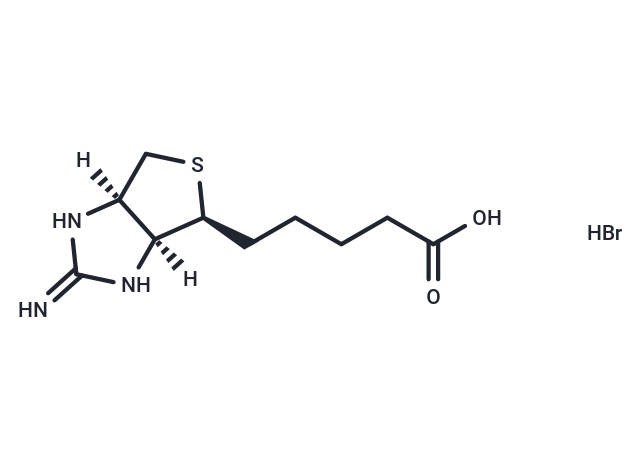Shopping Cart
- Remove All
 Your shopping cart is currently empty
Your shopping cart is currently empty

2-Iminobiotin hydrobromide (Guanidinobiotin) is a cyclic guanidino analog of biotin that acts as a reversible inhibitor of inducible nitric oxide synthase (iNOS) and neuronal NOS (nNOS; Ki of 21.8 and 37.5 μM for mouse iNOS and rat nNOS, respectively).

| Pack Size | Price | Availability | Quantity |
|---|---|---|---|
| 10 mg | $29 | In Stock | |
| 25 mg | Inquiry | In Stock | |
| 1 mL x 10 mM (in DMSO) | $108 | In Stock |
| Description | 2-Iminobiotin hydrobromide (Guanidinobiotin) is a cyclic guanidino analog of biotin that acts as a reversible inhibitor of inducible nitric oxide synthase (iNOS) and neuronal NOS (nNOS; Ki of 21.8 and 37.5 μM for mouse iNOS and rat nNOS, respectively). |
| Targets&IC50 | nNOS:37.5 µM(Ki)(rat), iNOS:21.8 µM(Ki) (mouse) |
| In vitro | All cultures were subjected to 25 h of hypothermia (33.5°C), and incubated with vehicle or 2-iminobiotin (2-IB) (10, 30, 50, 100, and 300 ng/ml).?Cell morphology was evaluated by brightfield microscopy.?Cell damage was analyzed by LDH assays.?Production of reactive oxygen species (ROS) was measured using fluorometric assays.?Western blotting for PARP, Caspase-3, and the phosphorylated forms of akt and erk1/2 was conducted.?To evaluate early apoptotic events and signaling, cell protein was isolated 4 h post-hypoxia and human apoptosis proteome profiler arrays were performed.?Twenty-five hour after the hypoxic insult, clear morphological signs of cell damage were visible and significant LDH release as well as ROS production were observed even under hypothermic conditions.?Post-hypoxic application of 2-IB (10 and 30 ng/ml) reduced the hypoxia-induced LDH release but not ROS production.?Phosphorylation of erk1/2 was significantly increased after hypoxia, while phosphorylation of akt, protein expression of Caspase-3 and cleavage of PARP were only slightly increased.?Addition of 2-IB did not affect any of the investigated proteins.?Apoptosis proteome profiler arrays performed with cellular protein obtained 4 h after hypoxia revealed that post-hypoxic application of 2-IB resulted in a ≥ 25% down regulation of 10/35 apoptosis-related proteins: Bad, Bax, Bcl-2, cleaved Caspase-3, TRAILR1, TRAILR2, PON2, p21, p27, and phospho Rad17[1]. |
| Cell Research | In vitro hypoxia was induced for 7 h in IMR-32 cell cultures by using our recently described system with minor modifications.?Enzyme stock solutions (100x) of catalase and glucose oxidase ?were diluted in cell culture medium (DMEM/F12, 1% FCS;?final concentration: 120 and 2 U/ml respectively).?A rapid decrease of partial pressure of oxygen (pO2) to levels below 10 mmHg was achieved by adding the enzymes to glucose containing culture medium.?Also a decline in glucose (<1 g/l) and pH (<7.0) was observed, resembling the clinical characteristics of hypoxic-ischemic injury in vivo.?Hypoxic conditions were confirmed with a tissue oxygen pressure monitor .?After the hypoxic insult, cells were washed twice with PBS and cultures were placed into an incubator at 33.5°C (hypothermia) employing culture medium with (i) solvent (citrate buffer 1%) or (ii) 2-IB at 10, 30, 50, 100, and 300 ng/ml.?To determine the optimal “reperfusion” time, a time-interval curve investigating cell damage (LDH release) was performed.?Analyses of LDH release, ROS generation, hydrogen peroxide release, metabolic activity, cell signaling, apoptosis-related protein expression/activity and expression analysis of 35 human apoptosis-related proteins were performed at different time points post-hypoxia[1] |
| Alias | Guanidinobiotin |
| Molecular Weight | 324.24 |
| Formula | C10H18BrN3O2S |
| Cas No. | 76985-52-9 |
| Smiles | [H][C@](CS[C@H]1CCCCC(O)=O)([C@]1([H])N2)NC2=N.Br |
| Relative Density. | no data available |
| Storage | Powder: -20°C for 3 years | In solvent: -80°C for 1 year | Shipping with blue ice. | |||||||||||||||||||||||||
| Solubility Information | DMSO: 12.5 mg/mL (38.55 mM), Sonication is recommended. | |||||||||||||||||||||||||
Solution Preparation Table | ||||||||||||||||||||||||||
DMSO
| ||||||||||||||||||||||||||

Copyright © 2015-2025 TargetMol Chemicals Inc. All Rights Reserved.